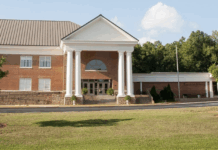
New teachers will be ready to explain science, math and technology to even their youngest students after acquiring skills themselves in a specialized North Alabama learning environment.
Athens State University’s Science, Technology, Engineering and Mathematics (STEM) Learning Lab opened in January. The classroom space equips pre-service teachers with strategies to instruct on problem-solving, teamwork and basic STEM principles.
STEM, of course, is a buzzword in today’s business and employment environment. Business leaders are eager to hire more STEM-literate workers.
Northrop Grumman Corp. made a significant donation to the lab to purchase a smart board, robotics, coding tools and STEM materials to prepare education students for the challenges ahead.
Dr. Erica Hopkins, K-12 STEM and Workforce Development lead at Northrop Grumman, says the company’s employees will offer their own expertise to pre-service teachers, too.
“It will be everybody from the rocket-science level to early career professionals that will come and engage with the teachers as they are getting that hands-on experience in the lab,” Hopkins says.
As part of the early childhood education program, students learn how to develop a STEM-oriented curriculum for their future classes.
“It’s really designed to give those teachers that confidence, that experience, before they actually go into the classroom,” Hopkins says, so “they’re already comfortable teaching some of those STEM subjects and they’ve already got experience doing hands-on STEM activities.
“I think it will definitely help give teachers that confidence and really develop the passion.”
Like a classroom
The “lab” is a defined classroom space in the Athens State University College of Education, says Dr. Marla Williams, assistant professor of elementary education at Athens State.
Teaching students train in person in the lab or attend live lessons from off-campus via Zoom.
“It’s designed like an elementary classroom but with STEM materials in it,” Williams explains. “We wanted our pre-service teachers to be able to come in and sit in an environment that looks like an elementary classroom but have all of the experiences that go along with the requirements for STEM.”
Williams calls it a virtual and real-world environment where students learn how to create cross-curricular lesson plans, among other things.
“They learn that they can teach science content using reading strategies,” Williams says, using materials found in the lab.
“We have 3-D printers where a lot of them can experiment for the first time ever how to create a 3-D printing lesson for students.” Many teaching students are overwhelmed by the idea of explaining 3-D printing because they haven’t had much experience with it, she says. Even the youngest children, though, can be taught 3-D basics.
“If they’re teaching a kindergarten or first-grade classroom, you can do a 3-D printing activity with them,” Williams says.

The STEM Learning Lab is set up for elementary and early-childhood education only. Secondary teachers have lab space elsewhere on campus.
“All of our early-childhood pre-service teachers and elementary teachers come through the STEM lab. They’re all taught the different ways to meet the needs of those students,” Williams says.
Besides 3-D printers, the lab space has robots for coding lessons, plus a variety of teaching literature. Williams says the lab already is in use but still under development. They need more items like teaching charts and basic classroom materials.
“We have big plans for it,” she says. “We’re all for trying anything new.”
Because standardized educational testing tends to focus on literacy and math comprehension, the science — particularly in the lower grades — “sort of gets pushed off to the side,” Williams says.
“We want to show our pre-service teachers how you can pull that science back in and embed it in those literacy lessons and make sure that science content is not being ignored.”
One lesson that could benefit all students is that failure is OK when trying something new, Williams says, “because you learn more from failure than you do from succeeding.
“That’s kind of our goal, for it to be well-rounded, for our pre-service teachers to know that you can really teach good, inspiring lessons where students try and fail and try and try again,” she says.
Some elementary school teachers teach general lessons, she says, but others at different schools may be expected to focus on specific subjects like science or math.
“Our goal is to make sure they have all the tools necessary and they have that good teacher toolbox with strategies and things they can pull out at any time regardless of what environment they’re in,” Williams says.
The biggest lesson is that “it is a demanding job, but the pros of teaching far outweigh the cons.”
More teachers, workers
Hopkins, at Northrop Grumman, hopes the lab will be one way to address a shortage of educators. She says the goal is to have a thousand teachers participate.
“Our hope is that all thousand of those teachers will go into the classroom and stay in the classroom,” Hopkins says. “We definitely need more educators going into the classroom, especially as it relates to STEM. In Alabama it’s going to help feed that pipeline. The teachers are really the ones that spark that interest and inspire students to go the STEM path.”

Most employees who work at Northrop Grumman have technical degrees, she says.
“It’s really important — in fact it’s imperative — for us to help develop students that are interested in pursuing STEM,” Hopkins says.
Many companies don’t have enough applicants to fill jobs they have now, much less meet expectations for the future.
“There are thousands, literally, of jobs — and I’m not saying just in Northrop Grumman but across the board — here and in North Alabama where we have all the aerospace companies. A lot of us are searching high and low for talent.
“A lot of times students don’t believe that they can be a rocket scientist or an engineer because they’ve never seen one that looks like them,” she says.
Northrop also gives scholarships to students around the state to attend Space Camp at the U.S. Space & Rocket Center in Huntsville.
Williams, who taught for 27 years, understands concerns that student teachers have about the emphasis on STEM. If they’re expected to teach science to young kids, how do they put together a curriculum? Where will the material come from? What will it cost?
“We need to answer these basic questions and get them past that point of uncertainty so we can just focus on the science of it,” she says.
Teachers can explain basic STEM principles with materials as simple as spaghetti, straws and water bottles. “They’re going to love it whether it’s a spaghetti stick or a 3-D printer,” Williams says.
Deborah Storey is a freelance contributor to Business Alabama. She is based in Huntsville.
This article appears in the April 2023 issue of Business Alabama.



